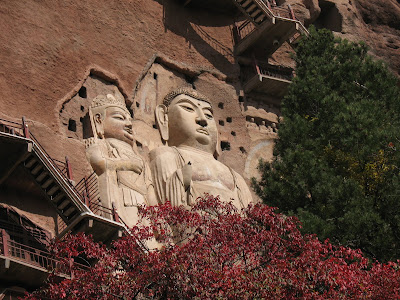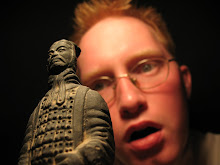The English Inquisition

[lightbulb casting intense light, fierce heat, and menacing shadows across the room]
"Tell me your name..."
"And now, let's have a look at your English...." [inquisition begins]The Examination Culture: an Introduction to InquisitionThe Exam. It deserves its capital "E" in China. Exams are everything. If Beijing is the capital of China, then Exams are the capital of education in China. And the University Entrance Exam is the Forbidden City. All faces turn toward Exam.In design, Exams are intended as a tool to measure learning outcomes. Here, this design has been warped into Frankenstein's monster--in the schools of China learning is a tool to achieve Exam outcomes (good grades). There's a significant difference between testing what I have learned and learning so that I can test. Although they both involve learning, is the quality of learning the same? Do these two different means reach the same end?My guess is no, but in truth this is work better left for specialists in educational research. These questions warrant careful, disciplined study. I will share, however, a few observations:
1) The students
do seem to be very knowledgeable. Their advanced knowledge of math and science have even been expressed and demonstrated through English conversations. Compared to American students, the knowledge (especially in math and science) seems to be better.
2)
Some of the knowledge seems pointless though. They constantly cite random facts and numbers (Mount Everest is such-n-such kilometers in altitude... and they quote this number down to the precise single digit!). And these random facts are not so random--they seem to ALL know them. I don't know how many times various students have told me how high Mount Everest is!
3) Higher level learning seems to be lacking. The social studies in general and history in particular are particularly concerning. While some students can remember names, dates, and places, few can think analytically about the historical events that they have studied. I doubt they have had any exposure to anaylsis and evaluation in these courses. And if there is no higher level learning, what on earth do they do in economics and sociology
(grade1 students have these classes once a week). I want to know how they study the social studies!!!
(I already have a hint though... I drew a supply-and-demand diagram... the students had never seen anything like it... come on now, what are they studying in economics?!?!?!?!?!?!)4) Some students use the Exam to decide not to even attempt certain learning outcomes. I encounter this everyday. Since oral English is nowhere on the exam, there are those who don't even try. They sit in the back... trying to sleep, trying to work on other homework, trying to play games on their phone... and now that I have taken all these options away, they just stare blankly like George Romero's zombies. The rest of the class is laughing and excited, and they just sit there sad, maybe a little angry, and dull. They
tingbudong, and they're going to
tingbudong for the rest of their lives with that attitude. Misguided by Exam.

My Own Inquisition
I told you in a previous post ("Sports Meeting") that students recently took mid-terms. Well the results are in, and they're not good. Students' English scores were particularly bad. This bad news is coupled with some other news (I discovered secretly), that last year this school underperformed on the University Entrance Exam. Whereas HuaiYa High School typically sends 4 to 6 students to Beida/Qinghua (the top universities of China) each year, last year not one student qualified for either of these plums. Apparently it was quite an embarrassment, and much pressure has been subsequently added (one administrator was demoted and teachers have been categorically blamed and pressed to work harder). So now, with these dismall mid-term exam scores, I wonder. Will there be an English Inquisition?
My nature is to immediately heap all the blame onto myself. I'm always ready to be my own judge, jury, and executioner. I also worry, though, what will the other teachers think of me. Will they blame me too? Will they think I'm not doing my job very well? 3 years from now when perhaps none of my students qualify to attend BeiDa, will they all look back and blame that "bad foreign English teacher!"
But then I snap out of it. Here at HuaiYa High School, I am the only one who inquires. None of the teachers or administrators even told me about the mid-term Exam results. I found out about the poor scores from asking my own students. I later asked one of the senior English teachers and he acknowledged the poor scores. And then when I asked if there was anything I could do to help the students improve, he laughed... said it had nothing to do with me. Do I have any responsibility at all?! (I guess he might be right though, when you consider that I teach oral English--which is not assessed--to students only one time a week, my responsibility is rather small). If the students do poorly, no one will fault me. If the students do well, no one will credit me. Makes my Inquisition quick, painless, and.... empty. So I continue to self-inquire... what can I do to improve the students' English?
What explains the students' poor English scores? After the teacher told me that I am not even in the equation, he then told me that the poor results were the fault of the test. "This time the questions were difficult, so the scores were poor. Next time the questions will be easier, so the scores will be better. It's nothing."
Now, it's time to revisit some of the content from my ETR 492 class. Here is my thought: in a culture with such a strong emphasis on Exams, wouldn't you think the exams should be meaningful? In ETR 492 language, these Exams should ideally be
reliable and
valid. We teachers need to know that the questions on the Exam produce consistent interpretations about what the students have learned.
I asked a student how he did on the mid-term. Like the others, he did poorly. His writing was really bad. Then I asked him how he did on the Shaanxi Provincial Exam (which grade1 and grade2 students took not more than a week later). On this exam he did really well. His writing was excellent. What in the Hell is going on here?!
Well, I guess if the questions vary as wildly between easy and difficult as the teacher mentioned above suggests, this might explain the discrepancy. But then there is the
cheating. I had a hunch about his. My Spidey senses...activated by the quirky smile on the student's face... were buzzing. I asked the student,
me: "How many teachers monitored the Shaanxi Provincial Exam.
Student: "None,of course"
me: "But the mid-terms were monitored by 4 teachers."
Student: "Yes"
me: "So... then... some students might cheat during the Shaanxi Provincial Exam."
Student: " Oh yes, of course, we all cheat!"
Hmmmm, if this dim-witted foreigner from Boone County could suspect such an outcome, I am certain that every last teacher is aware what happens during the exam too. This is sanctioned cheating.
But the school is only cheating itself. Presumably the school doesn't want to risk the gamble that serious performance issues might be revealed from the exam. They might lose face. So they forfeit the Shaanxi Exam as an assessment tool that can reveal such issues... that can target areas for long-term improvement and face-building. A farce Exam.
The English InquisitionAlthough I am living in a pressure-free universe, my other teachers are not. With each poor performance, they are given scoldings and more responsibilities. On that trend, last week the school held an "English Contest." The English teachers had to compose and deliver a free-topic speech and respond to one of an assortment of questions that I posed. I and two representatives from the Mei County Bureau of Education English Department were the judges. They called it a "contest" to make it sound fun.
There's not much to report here. The English teachers at HuaiYa High School have very good English. I understand them, and they understand me. They all did very well.
One interesting note: scoring. How do I score these teachers? What are the criteria by which I should evaluate them? I asked the organizer of the event, but he had initially had no suggestions. He said that because English is my mothertongue I can just give them scores! No sir, I need a rubric! So I made my own rubric. Initially my rubric consisted of three criteria: (1)
fluency of speech evaluated on a scale of 0-4, (2)
accuracy in grammar and word choice evaluated on a scale of 0-4, and (3)
directness in answering the questions evaluated on a scale of 0-2. They would get a score from 0-10.
Minutes before the contest, he approached me to ask if I had decided how to evaluate the teachers. Informing him that I had, he then told me what he thought my rubric should be. He had two criteria: pronounciation and fluency. Interesting. I missed pronounciation, and he missed accuracy. Both are important! I changed my rubric.
Even more interesting, he told me that I had to evaluate the teachers on a scale from 9.0 to 10.0 out of 10. So if a teacher scores no points, her score would be 9. A person could speak not one word of English; I would have to give them a 9.0 out of 10. Think about it. It's really the same exact scale as 0-10. That zero hiding behind the decimal isn't really hiding if you confront its meaning! The interpretation is the same. But the guaranteed, meaningless 9 in front of the decimal and the number that truly matter helps save face. Very interesting!
In the end, even my revised rubric with 4 criteria was not detailed enough. I ended up giving everyone scores between 9.7 and 10.o. So many 9.9s! It doesn't reflect the range of proficiencies. But truly, their English was collectively very good. Now we know that. And the English Inquisition is over.
What we don't know are all the important things. Do they
teach English well? Do I
teach English well? What can we do to improve? Do we even know what needs improvement?!


























































